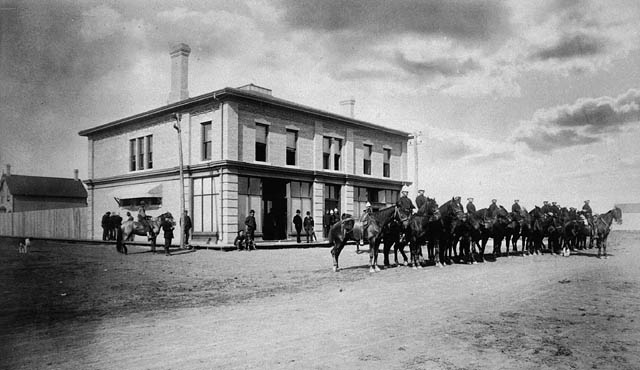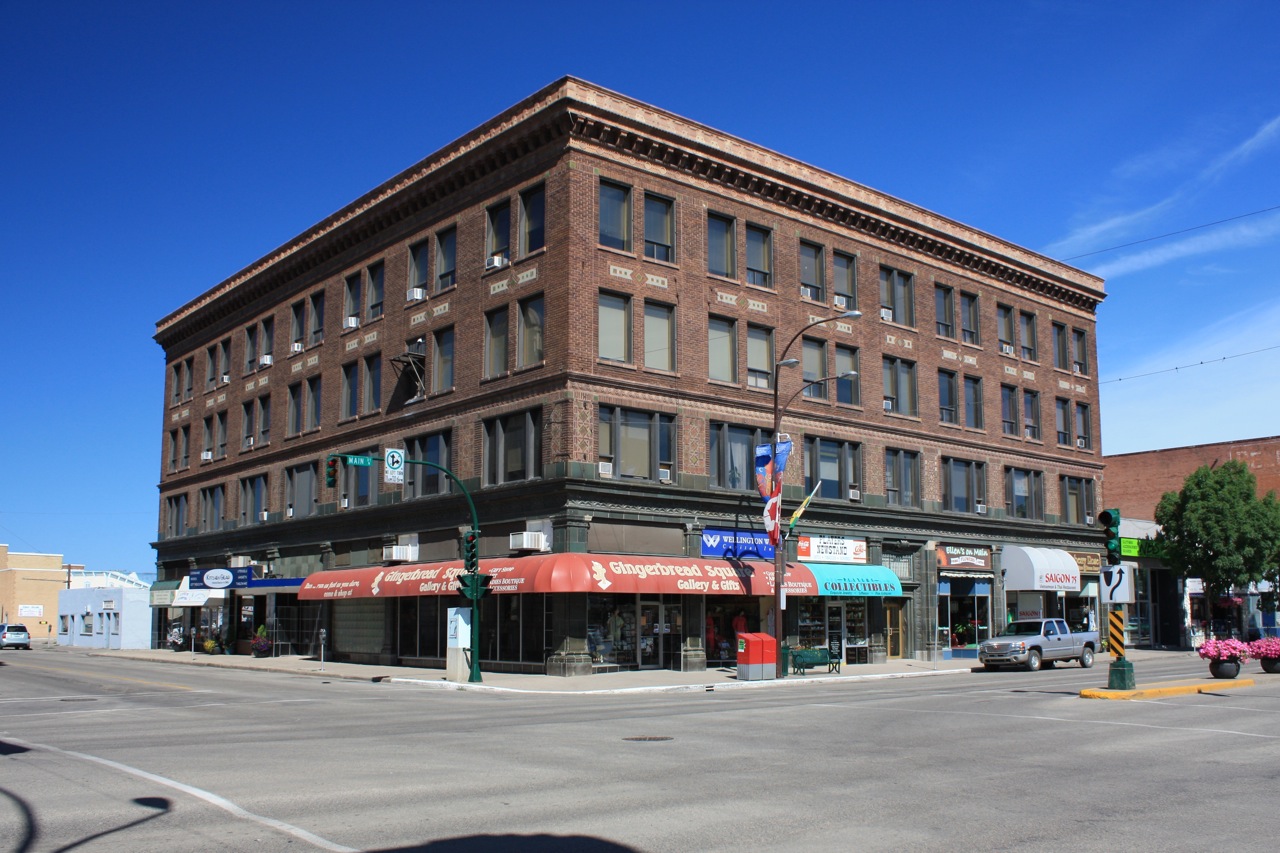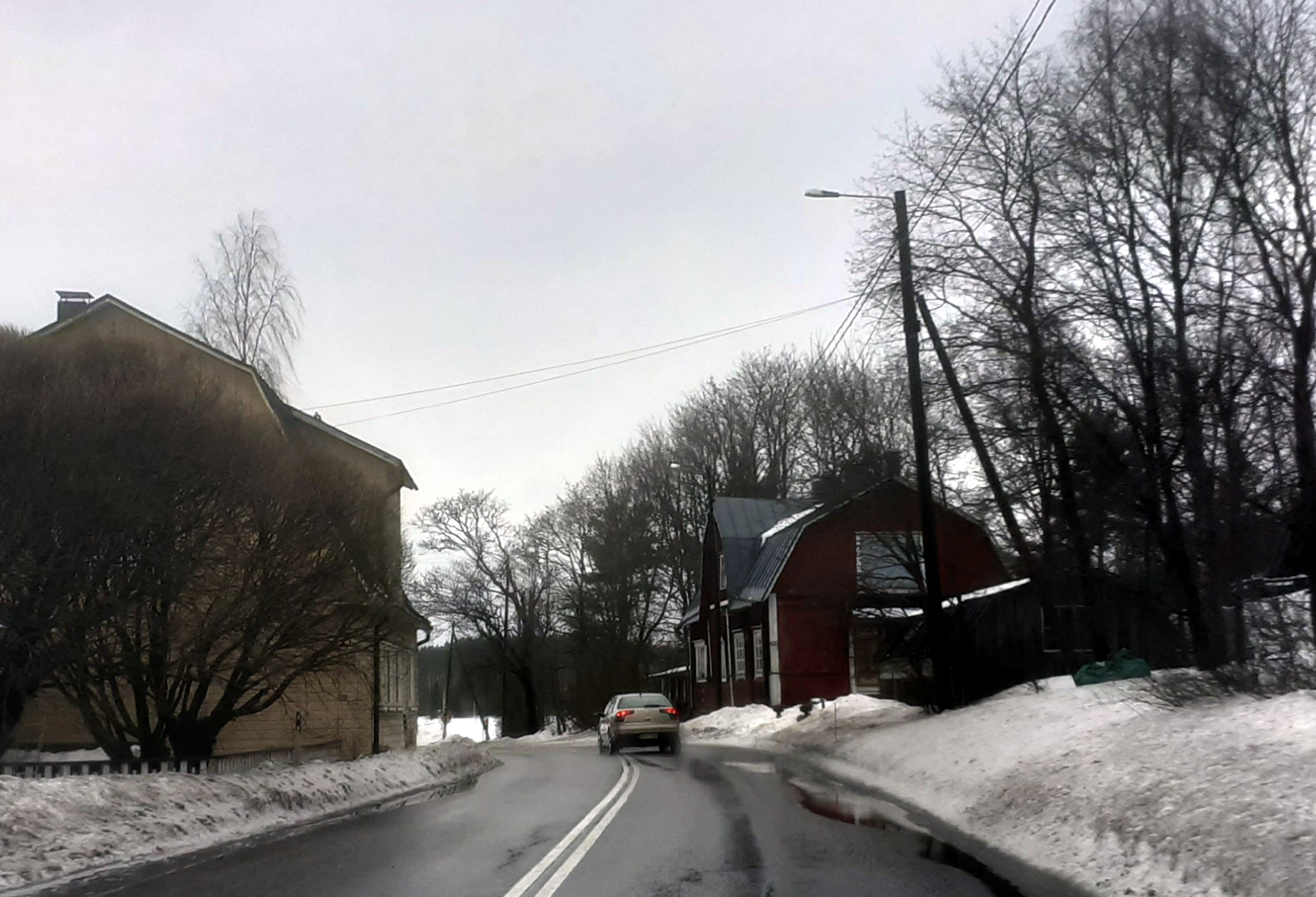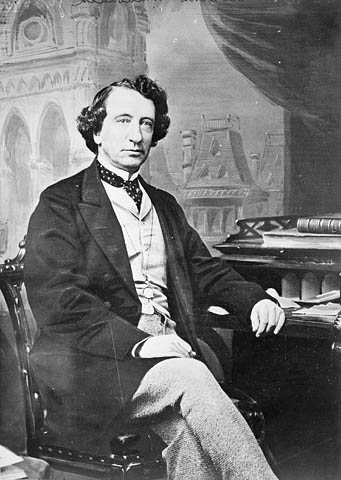|
Eyebrow, Saskatchewan
Eyebrow ( 2016 population: ) is a village in the Canadian province of Saskatchewan within the Rural Municipality of Eyebrow No. 193 and Census Division No. 7. The community originated at the location that is now the abandoned community of Eskbank several kilometres to the south. Eyebrow is located at the intersection of Highway 367 and Highway 42; 84 km northwest of Moose Jaw, 154 km northwest of Regina and 196 km south of Saskatoon. History A post office was established in 1904 called Eyebrow Hill located just south in Sec.12, Twp.20, R.2, W3 of the Dominion Land Survey. Eyebrow Hill was renamed Eskbank in 1908. The post office of Eyebrow Station (Sec.24, Twp.21, R.2, W3) was established in 1908 then was renamed Eyebrow six months later. Eyebrow incorporated as a village on January 8, 1909. Geography The Eyebrow Hills and Eye Lake are located north of the village (not to be confused with Eyebrow Lake located in the Qu'Appelle Valley near the vil ... [...More Info...] [...Related Items...] OR: [Wikipedia] [Google] [Baidu] |
List Of Villages In Saskatchewan
A village is a type of incorporated urban municipality in the Canadian province of Saskatchewan. A village is created from an organized hamlet by the Minister of Municipal Affairs by ministerial order via section 51 of ''The Municipalities Act'' if the community has: *been an organized hamlet for three or more years; *a population of 100 or more; *50 or more dwellings or businesses; and *a taxable assessment base that meets a prescribed minimum. Saskatchewan has 250 villages that had a cumulative population of 41,514 and an average population of 166 in the 2016 Census. Saskatchewan's largest village is Caronport with a population of 994, while Ernfold, Keeler, Krydor, Valparaiso and Waldron are the province's smallest villages with populations of 15 each. A village council may request the Minister of Municipal Affairs to change its status to a town if the village has a population of 500 or more. List Restructured villages The following is a list of former ... [...More Info...] [...Related Items...] OR: [Wikipedia] [Google] [Baidu] |
Village
A village is a clustered human settlement or community, larger than a hamlet but smaller than a town (although the word is often used to describe both hamlets and smaller towns), with a population typically ranging from a few hundred to a few thousand. Though villages are often located in rural areas, the term urban village is also applied to certain urban neighborhoods. Villages are normally permanent, with fixed dwellings; however, transient villages can occur. Further, the dwellings of a village are fairly close to one another, not scattered broadly over the landscape, as a dispersed settlement. In the past, villages were a usual form of community for societies that practice subsistence agriculture, and also for some non-agricultural societies. In Great Britain, a hamlet earned the right to be called a village when it built a church. [...More Info...] [...Related Items...] OR: [Wikipedia] [Google] [Baidu] |
Saskatoon
Saskatoon () is the largest city in the Canadian province of Saskatchewan. It straddles a bend in the South Saskatchewan River in the central region of the province. It is located along the Trans-Canada Yellowhead Highway, and has served as the cultural and economic hub of central Saskatchewan since its founding in 1882 as a Temperance colony. With a 2021 census population of 266,141, Saskatoon is the largest city in the province, and the 17th largest Census Metropolitan Area in Canada, with a 2021 census population of 317,480. Saskatoon is home to the University of Saskatchewan, the Meewasin Valley Authority (which protects the South Saskatchewan River and provides for the city's popular riverbank park spaces), and Wanuskewin Heritage Park (a National Historic Site of Canada and UNESCO World Heritage applicant representing 6,000 years of First Nations history). The Rural Municipality of Corman Park No. 344, the most populous rural municipality in Saskatchewan, sur ... [...More Info...] [...Related Items...] OR: [Wikipedia] [Google] [Baidu] |
Regina, Saskatchewan
Regina () is the capital city of the Canadian province of Saskatchewan. The city is the second-largest in the province, after Saskatoon, and is a commercial centre for southern Saskatchewan. As of the 2021 census, Regina had a city population of 226,404, and a Metropolitan Area population of 249,217. It is governed by Regina City Council. The city is surrounded by the Rural Municipality of Sherwood No. 159. Regina was previously the seat of government of the North-West Territories, of which the current provinces of Saskatchewan and Alberta originally formed part, and of the District of Assiniboia. The site was previously called Wascana ("Buffalo Bones" in Cree), but was renamed to Regina (Latin for "Queen") in 1882 in honour of Queen Victoria. This decision was made by Queen Victoria's daughter Princess Louise, who was the wife of the Governor General of Canada, the Marquess of Lorne. Unlike other planned cities in the Canadian West, on its treeless flat plain Regina h ... [...More Info...] [...Related Items...] OR: [Wikipedia] [Google] [Baidu] |
Moose Jaw
Moose Jaw is the fourth largest city in Saskatchewan, Canada. Lying on the Moose Jaw River in the south-central part of the province, it is situated on the Trans-Canada Highway, west of Regina. Residents of Moose Jaw are known as Moose Javians. The city is surrounded by the Rural Municipality of Moose Jaw No. 161. Moose Jaw is an industrial centre and important railway junction for the area's agricultural produce. CFB Moose Jaw is a NATO flight training school, and is home to the Snowbirds, Canada's military aerobatic air show flight demonstration team. Moose Jaw also has a casino and geothermal spa. History Cree and Assiniboine people used the Moose Jaw area as a winter encampment. The Missouri Coteau sheltered the valley and gave it warm breezes. The narrow river crossing and abundance of water and game made it a good location for settlement. Traditional native fur traders and Métis buffalo hunters created the first permanent settlement at a place called "the turn" ... [...More Info...] [...Related Items...] OR: [Wikipedia] [Google] [Baidu] |
Saskatchewan Highway 42
Highway 42 is a highway in the Canadian province of Saskatchewan. It runs from the intersection of Highway 2 and Highway 202 near Tuxford until Highway 15. Highway 42 is about long. The highway also passes the communities of Marquis, Keeler, Brownlee, Eyebrow, Central Butte, Lawson, Riverhurst, Lucky Lake and Dinsmore, Saskatchewan. Highway 42 crosses Lake Diefenbaker on the long Riverhurst Ferry The Riverhurst Ferry is a cable ferry in the Canadian province of Saskatchewan. The ferry carries Highway 42 across Lake Diefenbaker, linking Riverhurst on the east bank to Lucky Lake on the west bank. The ferry is operated by the Saskatchewan ... route and ice road in the winter. Major intersections From south to north: References 042 {{Saskatchewan-road-stub ... [...More Info...] [...Related Items...] OR: [Wikipedia] [Google] [Baidu] |
Saskatchewan Highway 367
{{Saskatchewan-road-stub ...
Highway 367 is a highway in the Canadian province of Saskatchewan. It runs from Highway 42 near Eyebrow to Highway 19 near Bridgeford. Highway 367 is about long. Highway 367 also connects with Highway 627. At that intersection is the community of Tugaske. References 367 __NOTOC__ Year 367 ( CCCLXVII) was a common year starting on Monday of the Julian calendar. At the time, it was known as the Year of the Consulship of Lupicinus and Iovanus (or, less frequently, year 1120 ''Ab urbe condita''). The denomination ... [...More Info...] [...Related Items...] OR: [Wikipedia] [Google] [Baidu] |
Eskbank, Saskatchewan
Eskbank is an unincorporated community in the Rural Municipality of Eyebrow No. 193, Saskatchewan, Canada. The community is located about south of Highway 42 on Range Road 20, approximately northwest of the City of Moose Jaw. It is located on the former Grand Trunk Pacific (Canadian National Railway) Central Butte Subdivision from Moose Jaw to Riverhurst. History Today nothing remains of Eskbank, only a historical plaque, placed at the site of the community in 2009. The post office of Eyebrow Hill was established June 1, 1904 in the home of John William Hudson, renamed "Eskbank" on June 1, 1908 after Eskbank, Scotland. The post office closed June 30, 1964. The last remaining buildings were burned by the rural municipality in 1975. The derelict Saskatchewan Wheat Pool grain elevator A grain elevator is a facility designed to stockpile or store grain. In the grain trade, the term "grain elevator" also describes a tower containing a bucket elevator or a pneumatic conveyo ... [...More Info...] [...Related Items...] OR: [Wikipedia] [Google] [Baidu] |
Village
A village is a clustered human settlement or community, larger than a hamlet but smaller than a town (although the word is often used to describe both hamlets and smaller towns), with a population typically ranging from a few hundred to a few thousand. Though villages are often located in rural areas, the term urban village is also applied to certain urban neighborhoods. Villages are normally permanent, with fixed dwellings; however, transient villages can occur. Further, the dwellings of a village are fairly close to one another, not scattered broadly over the landscape, as a dispersed settlement. In the past, villages were a usual form of community for societies that practice subsistence agriculture, and also for some non-agricultural societies. In Great Britain, a hamlet earned the right to be called a village when it built a church. [...More Info...] [...Related Items...] OR: [Wikipedia] [Google] [Baidu] |
Canada 2016 Census
The 2016 Canadian census was an enumeration of Canadian residents, which counted a population of 35,151,728, a change from its 2011 population of 33,476,688. The census, conducted by Statistics Canada, was Canada's seventh quinquennial census. The official census day was May 10, 2016. Census web access codes began arriving in the mail on May 2, 2016. The 2016 census marked the reinstatement of the mandatory long-form census, which had been dropped in favour of the voluntary National Household Survey for the 2011 census. With a response rate of 98.4%, this census is said to be the best one ever recorded since the 1666 census of New France. This census was succeeded by Canada's 2021 census. Planning Consultation with census data users, clients, stakeholders and other interested parties closed in November 2012. Qualitative content testing, which involved soliciting feedback regarding the questionnaire and tests responses to its questions, was scheduled for the fall of 2013, w ... [...More Info...] [...Related Items...] OR: [Wikipedia] [Google] [Baidu] |
Canadian Pacific Railway
The Canadian Pacific Railway (french: Chemin de fer Canadien Pacifique) , also known simply as CPR or Canadian Pacific and formerly as CP Rail (1968–1996), is a Canadian Class I railway incorporated in 1881. The railway is owned by Canadian Pacific Railway Limited, which began operations as legal owner in a corporate restructuring in 2001. Headquartered in Calgary, Alberta, the railway owns approximately of track in seven provinces of Canada and into the United States, stretching from Montreal to Vancouver, and as far north as Edmonton. Its rail network also serves Minneapolis–St. Paul, Milwaukee, Detroit, Chicago, and Albany, New York, in the United States. The railway was first built between eastern Canada and British Columbia between 1881 and 1885 (connecting with Ottawa Valley and Georgian Bay area lines built earlier), fulfilling a commitment extended to British Columbia when it entered Confederation in 1871; the CPR was Canada's first transcontinental railw ... [...More Info...] [...Related Items...] OR: [Wikipedia] [Google] [Baidu] |
Railway
Rail transport (also known as train transport) is a means of transport that transfers passengers and goods on wheeled vehicles running on rails, which are incorporated in Track (rail transport), tracks. In contrast to road transport, where the vehicles run on a prepared flat surface, rail vehicles (rolling stock) are directionally guided by the tracks on which they run. Tracks usually consist of steel rails, installed on Railroad tie, sleepers (ties) set in track ballast, ballast, on which the rolling stock, usually fitted with metal wheels, moves. Other variations are also possible, such as "slab track", in which the rails are fastened to a concrete foundation resting on a prepared subsurface. Rolling stock in a rail transport system generally encounters lower friction, frictional resistance than rubber-tyred road vehicles, so passenger and freight cars (carriages and wagons) can be coupled into longer trains. The rail transport operations, operation is carried out by a ... [...More Info...] [...Related Items...] OR: [Wikipedia] [Google] [Baidu] |





